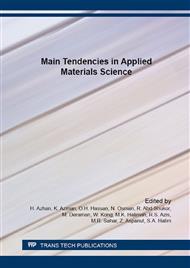[1]
E. Guillén, C. Fernández-Lorenzo, R. Alcántara, J. Martín-Calleja, J. A. Anta, Solvent-free ZnO dye-sensitised solar cells, Solar Energy Materials and Solar Cells. 93(10) (2009) 1846–1852.
DOI: 10.1016/j.solmat.2009.06.021
Google Scholar
[2]
M. K. Nazeeruddin, E. Baranoff and M. Grätzel: Dye-sensitized solar cells: A brief overview. Solar Energy. 85(6) (2011) 1172–1178.
DOI: 10.1016/j.solener.2011.01.018
Google Scholar
[3]
M. Grätzel, Dye-sensitized solar cells. J. of Photochemistry and Photobiology C: Photochemistry Reviews. 4(2)(2003) 145–153.
DOI: 10.1016/s1389-5567(03)00026-1
Google Scholar
[5]
M. Lira-Cantu, A. Chafiq, J. Faissat, I. Gonzalez-Valls, Y. Yu, Oxide/polymer interfaces for hybrid and organic solar cells: Anatase vs. Rutile TiO2. Solar Energy Materials and Solar Cells. 95(5) (2011) 1362–1374.
DOI: 10.1016/j.solmat.2010.12.028
Google Scholar
[6]
V. Savena, B.D. Malhotra, Prospect of Conducting Polymer in Molecular Electronics. J. Electrochem. Soc. 145 (2003) 999.
Google Scholar
[7]
www. sciencedaily. com/releases/2014/05/140519110158. htm.
Google Scholar
[8]
M. Wright, A. Uddin, Organic—inorganic hybrid solar cells: A comparative review. Solar Energy Materials and Solar Cells. 107 (2012) 87–111.
DOI: 10.1016/j.solmat.2012.07.006
Google Scholar
[9]
S. Erten-Ela, S. Cogal, G. Turkmen, S. Icli, Hybrid solar cells using nanorod zinc oxide electrodes and perylenemonoimide–monoanhydride dyes. Current Applied Physics. 10(1) (2010) 187–192.
DOI: 10.1016/j.cap.2009.05.018
Google Scholar
[10]
R. Thitima, C. Patcharee, S. Takashi, Y. Susumu,: Efficient electron transfers in ZnO nanorod arrays with N719 dye for hybrid solar cells. Solid-State Electronics 53(2)(2009) 176–180.
DOI: 10.1016/j.sse.2008.10.014
Google Scholar
[11]
M. Reinhard, J. Conradt, M. Braun, A. Colsmann, U. Lemmer, H. Kalt, Zinc oxide nanorod arrays hydrothermally grown on a highly conductive polymer for inverted polymer solar cells, Synthetic Metals. 162(17-18) (2012) 1582–1586.
DOI: 10.1016/j.synthmet.2012.06.018
Google Scholar
[12]
J. Zhang, Z. Han, M. Chen, X. Yang,W. Cao, Synthesis and application in solar cell of poly(3-dodecylthiophene)/titanium dioxide nanocomposite, Journal of Physics and Chemistry of Solids. 71(9)(2010) 1316–1323.
DOI: 10.1016/j.jpcs.2010.05.014
Google Scholar
[13]
L. Zhang, Y. -J. Zhu, ZnO micro- and nano-structures: microwave-assisted solvothermal synthesis, morphology control and photocatalytic properties, Applied Physics A. 97(4)(2009) 847–852.
DOI: 10.1007/s00339-009-5335-7
Google Scholar
[14]
J. Stejskal, M. Omastova, S. Fedorova, J. Proke, M. Trchova, Polyaniline and polypyrrole prepared in the presence of surfactants: a comparative conductivity study, Synthetic Metarials. 32 (2003) 541.
DOI: 10.1016/s0032-3861(02)00906-0
Google Scholar
[15]
D. Susanti, H.M. Sirat, F. Ahmad, R. M. Ali, N. Aimi, M. Kitajima: Antioxidant and cytotoxic flavonoids from the flowers of Melastoma malabathricum L. Food Chemistry. 103(3)(2007) 710–716.
DOI: 10.1016/j.foodchem.2006.09.011
Google Scholar
[16]
E. A. Ghapur, W.A. Dhafina, S. Hasiah, N.A.N. Ali: Effect of the ZnO Rods Growth Time to the Conductivity Of ZnO Thin Film Combined with N3 Dye, Proceeding of 2010 International Conference on Manufacturing Science and Technology (ICMST 2010)160 –163.
DOI: 10.4028/www.scientific.net/amr.383-390.3286
Google Scholar
[17]
Wikipedia. 2013. Spin Coating. http: /en. wikipedia. org/wiki/Spin_coating [9 June2013].
Google Scholar
[18]
R. Viswanatha, T.G. Venkatesh, C.C. Vidyasagar, Y.A. Nayaka, Preparation and Characterization of ZnO and Mg-ZnO nanoparticle. 4(1) (2012) 480–486.
Google Scholar
[19]
M. Shahrom and M. J. Abdullah, Tapered Head Facets Of Zinc Oxide Nanorods, Solid State Science and Technology. 15(1) (2007) 108-115.
Google Scholar
[20]
Y.J. Kim, H. Shang, G. Cao, Growth and Characterization of.
Google Scholar
[1]
ZnO Nanorod Array on ITO Substrate with Electric Field Assisted Nucleation, Journal of Sol-Gel Science and Technology. 38(1) (2006)79–84.
DOI: 10.1007/s10971-006-5731-9
Google Scholar
[21]
Z. Yuan, J. Yu, N. Wang, Y. Jiang, Well-aligned ZnOnanorod arrays from diameter-controlled growth and their application in inverted polymer solar cell, Journal of Materials Science: Materials in Electronics. 22(11) (2011) 1730–1735.
DOI: 10.1007/s10854-011-0353-6
Google Scholar


